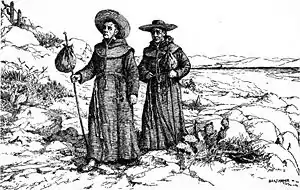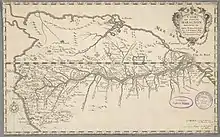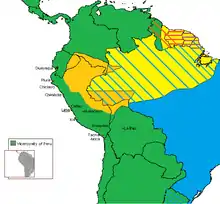Mainas missions
The Mainas (or Maynas) missions were a series of missions the Jesuits established in the Western Amazon region of South America from 1638 until 1767, when the Jesuits were expelled.[1][2] Following the Jesuit expulsion, mission activity continued under Franciscan auspices.[3]
Part of a series on |
| Spanish missions in the Americas of the Catholic Church |
|---|
 |
| Missions in North America |
| Missions in South America |
| Related topics |
|
|
Roughly 60 missions were founded in total.[4] Scholar Anne Christine Taylor notes that, '[o]f all the western Amazonian mission establishments, that of the Jesuits of Mainas was by far the most important'.[5] She estimates that, at its zenith, the mission field had a population of approximately 200,000.[6] However, throughout their existence, the Jesuit mission settlements—known as reductions—were marked by epidemic disease (often smallpox) that exacted a tremendous death toll on the indigenous peoples installed in them.[6]
'Maynas' or 'Mainas' refers to the Maina people, indigenous to the area around the Marañón River.[7] The area in which the missions were conducted is now largely coextensive with Maynas Province, Peru, which borders Ecuador. The Jivaro, Kokama, Cambeba, Secoya, and Yame were among the other indigenous peoples the missionaries sought to convert.[8]
History
The Mainas missions were one element of the broader Spanish colonial project in the Americas. Taylor characterizes the object of the missions as 'pav[ing] the way for the spread of colonial institutions through cultural means'—using religious and other ideological tools to induce indigenous people to conform to colonial priorities.[9]
The missions were not completely allied to the colonial state, however. The Jesuits sought to convert indigenous forms of government into reductions, whereas the colonial governors aimed to subject them to the encomienda or repartimiento systems of labour extraction. At times, then, there was conflict between the religious orders and the state with regard to control over the indigenous population. Thus, the two organizations were allied in complex ways in the Western Amazon from the 17th to 19th centuries.[9]
Our knowledge of the Mainas missions derives largely from missionaries' own accounts of their activities. Thus, as Newson notes, a complete account is 'difficult to establish in detail'.[10]
Rebellion
The immediate impetus for missionary work in the region was a 1635 (or 1637,[11] or 1640[12]) rebellion by the Maina people against Spanish colonialists.[2][13][lower-alpha 1] The Maina rebelled against the encomienda system, a system analogous to slavery which 'gave individual Spaniards the right to demand labor and tribute from the Indians assigned to them … and also turned them into de facto administrators, responsible for the control and the welfare of these Indians'.[14]
Reeve describes the system, as practised in the early 17th century in Mainas, as 'exceedingly harsh': the vast majority of indigenous peoples co-opted into Mainas encomiendas died, and the colonial government used military force to put down those who had not been brought into the system.[15]
The colonial strategy changed around 1636–38, however. According to Clements Markham, Pedro Vaca de Vega (known as Don Pedro Vaca and styled Governador de los Maynas[16]), the colonial governor of Mainas province, had 'despaired of subjugating the Indians by force' and hoped that the Jesuits 'might succeed in tranquillizing them by persuasion'.[17][12] Accordingly, he hoped to bring Jesuit missionaries to the area. Reeve concurs, suggesting that the governor's change of heart was due to the recent history of violence in the area.[15]
17th century

Two missionaries, then at Quito, initially responded to Vaca's request for mission-founders: Father Lucas de la Cueva (known as Father Cueva) and Father Cujia.[17] Fathers Cueva and Cujia arrived at Borja on 6 February 1638,[18] not long after the city was founded in 1619.[13]
Mission activity began in the area around Borja, in the valley of the Huallaga River (a tributary of the Marañón).[19] The Jesuits sought to 'induc[e]' indigenous peoples to settle in reductions, as opposed to their traditional modes of habitation and forms of government.[20] This would have been a difficult assignment in the best of circumstances, coming as it did shortly after a violent rebellion. More so, because although the Jesuits would ultimately found 'dozens' of missions in the region, there were not many missionaries to go around.[20] Nonetheless, by 1660, the Jesuits had 'catechized' around 10,000 people.[4] Newson estimates that this was about 10–15 percent of the indigenous population in the region at the time.[19]
The missions were backed by colonial forces. The Jesuits travelled with soldiers, and the colonial governor would periodically send his forces on entradas—a missionary's initial attempt to establish contact with those he sought to convert, using 'food and gifts' as inducement.[21]
Reeve notes that the missionaries were largely dependent on 'indigenous guides and interpreters' in seeking out new fields for expansion: guides would bring the Jesuits to territories their people knew well, or with which their people were allied. She observes, then, that '[t]o a remarkable degree, the process of proselytization and mission formation followed indigenous alliance networks across the region'.[4]
18th century

Samuel Fritz served as superior of the Mainas missions from 1704–12.[22] Fritz sought to expand the missions further outwards, which provoked trouble with Portuguese slave traders.
After the Jesuits were expelled in 1767, Maynas came under the control of Franciscans.[3]
19th century
There was evidently a mission infrastructure in Mainas as late as the 1850s. William Lewis Herndon, exploring the Amazon for the United States Navy, described missions in the Mainas region that traded various goods with Brazil. He further noted:
I know of no legal establishment in the Missions—the law proceeding out of the mouths of the governors. Indians are punished by flogging or confinement in the stocks; whites are sometimes imprisoned; but if their offence is of a grave nature, they are sent to be tried and judged by the courts of the capital.[23][24]
Herndon also observed that the indigenous inhabitants of the Mainas missions, unique among the 'Indians of Peru', had been exempted from the payment of a head tax, because 'these people had the forest to subdue, and were only able to wring a hard-earned support from the cultivation of the land'. He remarked that white settlers objected to this, and thought that 'some law compelling them to work' would be preferable.[25][lower-alpha 2]
Effects
Disease and slavery were common in the Mainas missions.
Over the 129 years of Jesuit missionary activity in the Mainas region, numerous epidemics of smallpox and other diseases exacted a severe toll on indigenous peoples.[12][26]
Slave raids, whereby Portuguese colonialists, known as bandeirantes, would capture and enslave indigenous people, were frequent throughout the period.[27] Fritz's tenure in the Mainas missions, in particular, was marked by a number of Portuguese slave raids.[28]
See also
Jesuit missions in neighboring countries
- Jesuit Block and Estancias of Córdoba (Argentina)
- Jesuit missions of the Guaraní (Argentina and Brazil)
- Jesuit missions of La Santisima Trinidad de Paraná and Jesús de Tavarangue (Paraguay)
Notes
Explanatory notes
- Accounts of the precise date of this rebellion vary widely, but it—perhaps in multiple instalments—probably occurred between 1635 and 1640.
- This head tax evidently had historical roots in medieval Spanish practices. See Simpson, Lesley Byrd (1982). The Encomienda in New Spain: The Beginning of Spanish Mexico. Berkeley, California: University of California Press. p. 150. ISBN 978-0-520-04630-6.
References
- Livi-Bacci 2016, p. 426–27.
- Reeve 1993, p. 118.
- Hsia, Ronnie Po-chia (2017). A Companion to Early Modern Catholic Global Missions. Boston: Brill. p. 57. ISBN 978-90-04-35528-6. OCLC 1019889142.
- Reeve 1993, p. 119.
- Taylor 1999, p. 223.
- Taylor 1999, p. 225.
- Livi-Bacci 2016, p. 424.
- Waisman 2020, p. 113.
- Taylor 1999, p. 219: 'In effect the role of the missions was to pave the way for the spread of colonial institutions through cultural means, essentially by indoctrinating the Indians in the pedagogic virtues of work and ridding them of their habits of 'laziness', the root of their condition as savages. … Colonists and the religious themselves suffered conflicts of interests too. Both competed in capturing the Indians, either for encomiendas or reductions as well as for the meager wealth they could provide; yet the two sectors depended on each other for their own survival'.
- Newson 1995, p. 306.
- Markham 1859, p. xvii.
- Steward, Julian Haynes (1946). Handbook of South American Indians. 3. Washington, DC: Government Printing Office. p. 630. Smithsonian Institution Bulletin 143.
- Livi-Bacci 2016, p. 426.
- Keith, Robert G. (August 1971). "Encomienda, Hacienda and Corregimiento in Spanish America: A Structural Analysis". Hispanic American Historical Review. 51 (3): 431–446. doi:10.1215/00182168-51.3.431. ISSN 0018-2168.
- Reeve 1993, p. 116.
- Rodriguez, Manuel (1684). El marañon, y amazonas: Historia de los descubrimientos, entradas, y reducción de naciones (in Spanish). Madrid: Imprenta de Antonio Gonçales de Reyes. pp. 93, 211.
- Markham 1859, p. xviii.
- Markham 1859, p. xix.
- Newson 1995, p. 307.
- Livi-Bacci 2016, p. 427.
- Crosby, Harry W. (1994). Antigua California: Mission and Colony on the Peninsular Frontier, 1697–1768. Albuquerque, New Mexico: University of New Mexico Press. p. 191. ISBN 0-8263-1495-3. OCLC 29310787.
- Anderson, Gerald H. (1998). Biographical Dictionary of Christian Missions. New York: Macmillan. p. 229. ISBN 0-02-864604-5. OCLC 36017191.
- Herndon, William Lewis (1854). Exploration of the Valley of the Amazon. Washington, DC: Robert Armstrong, public printer. p. 181. Part I.
- Herndon 1854, p. 181.
- Herndon 1854, p. 215–16.
- Huertas Castillo, Beatriz (2004). Indigenous Peoples in Isolation in the Peruvian Amazon: Their Struggle for Survival and Freedom. Copenhagen: International Work Group for Indigenous Affairs. pp. 89–92. ISBN 87-90730-77-1. OCLC 59882011.
- Seed, Patricia (2001). American Pentimento: The Invention of Indians and The Pursuit of Riches. Minneapolis, Minnesota: University of Minnesota Press. pp. 139–40, 143. ISBN 978-0-8166-9261-3. JSTOR 10.5749/j.cttttdwx. OCLC 191930398.
- Goodman, Edward Julius (1992). The Explorers of South America. Norman, Oklahoma: University of Oklahoma Press. pp. 126–29. ISBN 978-0-8061-2420-9.
Sources
- Reeve, Mary-Elizabeth (1993). "Regional Interaction in the Western Amazon: The Early Colonial Encounter and the Jesuit Years: 1538–1767". Ethnohistory. 41 (1): 106–138. doi:10.2307/3536980. JSTOR 3536980.
- Livi-Bacci, Massimo (30 August 2016). "The Depopulation of Upper Amazonia in Colonial Times". Revista de Indias. 76 (267): 419–448. doi:10.3989/revindias.2016.013. ISSN 1988-3188.
- Markham, Clements Robert (1859). Expeditions into the Valley of the Amazons. London: T. Richards (for the Hakluyt Society).
- Newson, Linda A. (1995). Life and Death in Early Colonial Ecuador. Norman, Oklahoma: University of Oklahoma Press. p. 306. ISBN 0-585-11850-7. OCLC 44955330.
- Taylor, Anne Christine (28 October 1999), Salomon, Frank; Schwartz, Stuart B. (eds.), "The Western Margins of Amazonia from the Early Sixteenth to the Early Nineteenth Century", The Cambridge History of the Native Peoples of the Americas, Cambridge University Press, 3, pp. 188–256, doi:10.1017/chol9780521630764.005, ISBN 978-1-139-05379-2
- Waisman, Leonardo (2020), Newson, Linda A. (ed.), "Music in the Jesuit Missions of the Upper Marañón", Cultural Worlds of the Jesuits in Colonial Latin America, University of London Press, pp. 111–126, ISBN 978-1-908857-62-0, JSTOR j.ctvwrm4h1.10
Further reading
| Wikisource has original text related to this article: |
- Francisco de Figueroa (1904) [1661]. Relación de las misiones de la compañía de Jesús en el país de los Maynas (in Spanish). Madrid: Librería general de Victoriano Suárez. An extended chronicle of the Mainas missions.